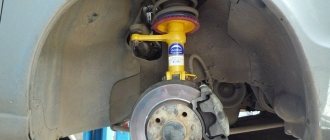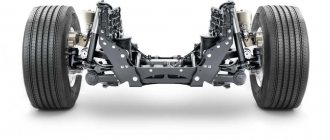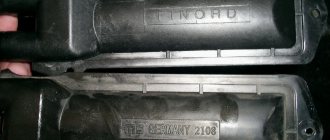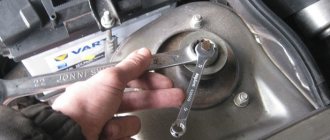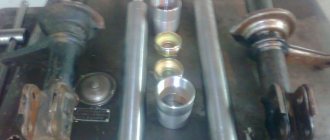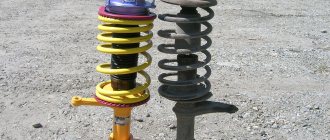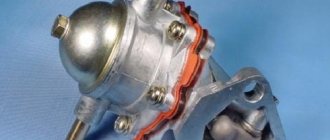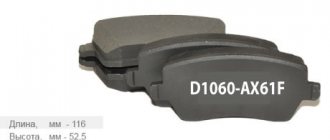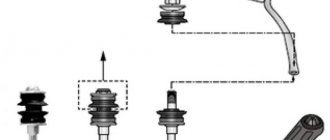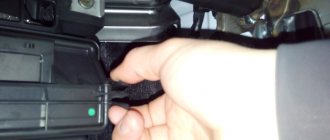Causes of failure
There are two main reasons why rear shock absorbers begin to misbehave:
- When driving, the rear wheel can gradually wear out the locker, made of plastic. It serves to protect the rack. Over time, the wheel gets closer and closer to the stand;
- If the breakage occurs along the lower silent block, the culprit is the bolt holding it in place. It was simply not tightened to the required load.
Worn out old shock absorbers
When changing the strut, pay special attention to this bolt. If you make the same mistake again, you will soon have to make repairs again.
Symptoms of a problem
Pay attention to the telltale signs that tell you that you need to take action to correct problems with your rear struts.
| Sign | Peculiarities |
| The silent block has changed | Cracks, various kinds of defects, and flaws may appear on this element. This indicates wear, so the shock absorber should be replaced. |
| The gaskets and boot have lost their elasticity | While these elements are working, they are clearly limp in appearance. This is a serious signal that the rubber components will soon break and this will lead to sad, expensive consequences. |
| The compression buffer is damaged or deformed | Everything in the system operates under high pressure. And if the gasket doesn't do its job properly, pressure is applied to the buffer and it breaks. |
| The spring has cracks | Everything here is more than logical and understandable. If signs of spring deformation appear, it must be replaced. At the same time, you can check the condition of the remaining nodes |
Silent block
Symptoms of a problem
Racks may require repairs for several reasons:
- Presence of manufacturing defects in installed racks;
- The appearance of dull knocks of shock absorber supports on the car body. Usually occurs when driving on uneven, bumpy roads;
- Unpleasant squeaks that appear when starting or stopping the car;
- Traces of leakage of shock-absorbing fluid;
- The rack is dirty, it becomes wet, dirt quickly sticks;
- The car shakes even when driving on a flat road.
Even the best quality repairs do not provide a lasting effect. This is a temporary measure, which will definitely require the racks to be completely replaced soon.
Replacement
To replace or partially repair you have to go through a rather labor-intensive path.
You will need the following set of tools and materials:
- Screwdriver Set;
- Set of wrenches;
- Jack;
- Partner.
Decide in advance whether you are going to change the entire assembly, or whether you want to change only the damaged elements of the rear pillar. The volume of your purchases depends on this.
You can start working. Based on our instructions and the video lessons provided, you will be able to replace the rear struts yourself.
- Turn the gearbox into first gear mode.
- Raise the rear wheels using a jack.
- Install supports, strengthening the reliability of fixing your car in a given position.
- Remove the racks. To do this, first go to the trunk, remove the decorative rubber plug, which is located on top of the rack mount. It is better to remove all unnecessary things from the trunk.
- Take a 17-size spanner and a 6-size open-end wrench. With their help, you can unscrew the nut with a spanner, and the open-end wrench will be useful for holding the shock-absorbing strut rod.
Removal process
- That's it, this allows you to remove the mounting nut, support washer, spring washer and top pad without any problems.
- Now we go under the car to finish what we started.
- Take a 19 mm wrench and remove the shock absorber mounting bolt to the rear beam. Remove it.
- In some cases, problems may arise with dismantling this bolt, since it simply sticks. To do this, pre-treat the bolt with the almighty WD40 and give it time to react.
- If even this method did not help, then you will have to take the guide and simply knock out the fastening element.
- Next, remove our shock absorber along with the spring.
- Do not forget that during such manipulations most often the spring gasket remains on the body. It sticks to the metal. Many people forget to take it out, which causes difficulties during reinstallation. Don't make this mistake.
- Clean all the seats to make it more convenient for you and make it all look more aesthetically pleasing. Plus, neatness never hurts to extend the service life of new spare parts.
- To make it more convenient for you, wrap the gasket on the new spring with electrical tape, or secure it with thin wire. This will prevent it from slipping when you begin installation.
- When putting the assembly back together with the new rear strut, be sure to make sure that the raised portion of the spring cup faces the direction of the wheel.
- Secure the lower end of the rack with a nut and bolt, but there is no need to tighten the fasteners just yet.
- Using the lever of your jack, raise and lower the rear of the car. This is necessary in order to eventually insert the shock absorber rod into the hole in the body of your nine.
- With the spring in place, pull the shock absorber rod out to its full length.
- Insert the rod into the lower ear and secure with a bolt.
- Place a jack under the beam and begin manipulating the lifting mechanism.
- At the same time, the spring will begin to compress, and the rod will move towards the glass.
- You or your assistant must be alert in the car in order to have time to pry the rod with a screwdriver and ensure it is directed in the right direction.
- Once the rod is in place, the work can be considered almost complete.
- Fix the rod, not forgetting to insert the cushion, washer and engraver. All this is securely fixed.
- Now you can lower the car onto its own wheels and fully tighten the bolt of the lower shock absorber mounting.
Reassembly stage
Changing rear strut assemblies is easier and faster than dismantling, disassembling the old strut, looking for defects in it and replacing individual damaged components. But this requires less financial costs.
Changing racks is not that difficult, even if you have little experience in such matters. But if there are none, be sure to contact trusted car services. Do not risk your own car, otherwise subsequent repairs will be even more difficult and expensive.
How to remove and install the front ones on the “nine”
It is somewhat more difficult to remove the front strut from the car and change it, so when performing work it is important not to deviate from the prescribed instructions. To replace the front shock absorber, you must perform the following steps.
- Remove the protective cap of the desired pillar under the hood of the car. The cap, which prevents dirt from penetrating the rack, can be removed without additional tools - just grab it and apply a little force.
Removing the plug - After removing the cap, loosen the nut located inside the shock absorber rod. To do this, put the small part of the removable key on the rod and install the larger part on top.
Loosen the stem nut - Raise the car with a jack and remove the wheel from the side where the faulty shock absorber strut is located. Then use pliers to remove the cotter pin.
We take out the cotter pin - Unscrew the nut that secures the ball joint, and then remove it from the hole.
Removing the ball joint - Move the brake hose away from the bracket to avoid damaging it.
It is better to hide the bracket hose - Remove the front steering knuckle and all the components located on it. Next, unscrew the mounting nut on the top of the shock absorber and remove the strut.
Dismantling the rack - Following the reverse procedure, install the new shock absorber strut in place. Once the process is complete, perform a wheel alignment and camber check.
After replacing shock absorber struts, it is important to check the secure fit of all fasteners. In this case, even if all parts are secured, the check should be repeated after 100 kilometers of the vehicle.
Self-replacement of rear struts of VAZ-2109
Any breakdown in a car requires immediate repair, since in most cases the breakdown leads to a decrease in the level of safety during operation.
In this article we will tell you how to replace the rear struts of a VAZ-2109. You should know that, as a rule, a problem is indicated by a very characteristic noise coming from the rear suspension while driving the car.
If you do not have sufficient knowledge, then it would be better to seek help from an auto repair shop. But it is worth saying that with some effort you can make the replacement yourself.
Reasons for failure of the rear strut
There are quite a lot of them, but the most common ones are:
- abrasion by the rear wheel of the locker protecting the rack itself;
- fracture of the element in question in the area of the lower silent blocks.
The latter often occurs when the fixing bolt was tightened without load.
Signs of malfunction:
- The silent block has various types of damage - cracks or other defects;
- the rubber seal and boot have lost their elasticity;
- the compression buffer was deformed;
- There are cracks directly on the springs.
Such problems require immediate replacement of the rack or its individual elements - otherwise there is a risk of breaking it and causing even greater damage, which is much more difficult to eliminate.
As practice shows, many car enthusiasts, in order to do without spring tensioners, cut off several turns from them. This, among other things, achieves a decrease in clearance. This should not be done under any circumstances.
Replacement procedure
For such work you need the following devices and tools:
- screwdriver set;
- a set of keys;
- jack;
- container for draining shock-absorbing fluid.
The procedure is as follows:
- at the gearbox, switch the lever to first speed;
- lift the rear of the car with a jack (both wheels must be in the air);
- provide reliable support;
- take away the jack;
- dismantle the old racks.
If you need to completely replace them, then the disassembly process ends.
When you need to repair any individual element, you should also perform the following steps:
- remove the anthers, bushings and buffer;
- make sure that there are no noticeable flaws;
- wash the shock absorber (it is its contamination that most often leads to breakdown);
- check the rear silent blocks;
- assemble the stand and install it in place.
It is very difficult for one person to complete all the actions on his own, so it is worth asking a friend for help.
In particular, your partner will have to direct the rod into the glass. Further:
- install the spring;
- pull out the shock absorber rod completely;
- put on the lower ear and clamp everything with a bolt as tightly as possible.
Required Tools
You can remove faulty racks and install new ones in their place yourself. To do this you will need the following set of tools and accessories:
- Socket head for 17 and 19.
- Mount.
- Socket wrench.
- Jack.
- Pliers.
- Ratchet handle.
- Collar.
- Wrenches for 17 and 19.
- Penetrating lubricant.
- A key to keep the shock absorber rod from accidentally turning.
A special wrench prevents the nut from turning while unscrewing
How to check a shock absorber
To make sure it works, you will need to do the following:
- it is clamped in a vertical position;
- raise to the maximum;
- quickly lowered.
This procedure must be repeated several times.
The following signs indicate failure of this part:
- presence of sounds during the above procedure;
- jamming;
- failure.
This shock absorber is replaced with a new one.
However, before doing this, it is better to make sure that any individual element is not damaged. If this is the case, then only what is broken is replaced. The procedure is as follows:
- the rod is pulled out to the maximum;
- the nut is unscrewed;
- take out the fixing elements and the rod itself;
- remove the working cylinder;
- every detail is inspected.
If defects are found, they are replaced. Assembly is carried out in reverse order.
After installing the compression valve, you need to make sure that its discs move smoothly. Jamming is not acceptable.
Finally, it’s worth telling that on average in Russia a new rack will cost approximately 3 thousand rubles. As you can see, the price is quite serious, and therefore it makes sense to treat the car more carefully and regularly care for it.
To fully familiarize yourself with the process, we recommend watching the video below:
Replacing rear struts on a VAZ 2109: how to do it right
Rear struts and their replacement on a VAZ 2109
In a VAZ 2109 car, replacing the rear struts is simply necessary if they are even slightly damaged. Otherwise, driving your own car will bring nothing but trouble.
Typically, such a breakdown leads to extraneous noise being heard in the rear suspension. Replacement of the rear struts of a VAZ 2109 is carried out either at a service station or in your own garage.
How to carry out this work yourself will be described in this article.
Which rack should you choose?
Today, car dealerships sell several types of shock absorbers. Each has its own characteristic differences. The manufacturer installs oil shock absorbers at the factory. They hide unevenness perfectly. However, if the car moves at high speed, they begin to rock the body, and loss of control is possible.
Fans of fast driving can be advised to install gas shock absorbers. This is a rather rigid structure, bumps will be felt in the cabin, but the swaying will completely disappear and the car will be stable on the track.
You can also find gas-oil struts. They are considered a middle type, between standard and gas shock absorbers.
Reasons for failure of the rear struts on the VAZ 2109
Replacing rear struts on a VAZ 2109
There may be several reasons why the rear shock absorber strut is not functioning properly:
- It is possible that the rear wheel wears out the plastic locker that protects the strut while driving. This leads to the fact that over time the wheel “makes its way” to the rack.
- If the strut breaks off along the lower silent block, then most likely the bolt that holds it was not tightened under load.
Note : therefore, when replacing the rack, you need to pay attention to this bolt if you do not want to carry out repair work again soon.
How to understand that the rear pillar needs repair
VAZ 2109 rear strut extension
Signals that repairs need to be done can be different:
- The silent block has changed slightly. Perhaps there are cracks or other types of flaws on it.
- The boot and rubber gasket have become limp and less elastic.
Note: if they haven't broken yet, they definitely will soon. Therefore, it is advisable to replace them in a timely manner.
- The compression buffer is deformed or damaged. Because everything in the system works under high pressure, and the rubber gasket does not work normally, but all this pressure “presses” on the compression buffer. Ultimately, this leads to its breakdown.
- Small cracks appeared on the spring.
Note: if the spring is somehow deformed, it should be replaced immediately. At the same time, some drivers, wanting to “lower” their car, deliberately cut off several coils of the spring.
Front suspension VAZ 21099
For the VAZ 21099, the front suspension is the most complex element in the car, since the car is front-wheel drive. But the number of main nodes is small.
During each preventive self-examination, you need to pay attention to:
- the presence of operational defects on the balls;
- traces of deformation of the suspension by the body or external objects;
- any cracks or irregularities on the suspension;
- defects in the elements of any joints in the components of the front part of the machine, ranging from braces to levers and stabilizer, including hoses and struts;
- wheel angle, because any deformation makes work on their correct camber and toe useless;
- integrity and wear of silent blocks;
- absence of cracks and defects on the rubber bands of the stabilizer cushion;
- subsidence of telescopic suspension struts.
No parts should have cracks, bruises, traces of oil, torn fragments, or bulging rubber bands on one side.
To check the performance of the ball, measure the distance from the support disk to the lever in front. When, during the swing of the chassis, the distance varies by plus or minus 0.8 mm or more, it is necessary to change the ball joint.
When rocking, the hub should not knock - the sound means the bearing needs to be replaced.
When, when starting to move, the car begins to make a hum/vibration/unintelligible knocking sound or the vehicle pulls in a certain direction, this indicates a malfunction in the front suspension system.
How to remove the front suspension arm
Before inspecting the lever, the front part of the machine is fixed on a support (or on a pair of raised jacks), the parking (hand) brake is depressed, and the rear wheels are secured in a stationary position with “shoes”.
Using the 17th key, unscrew the four bolts and the wheel is removed. By unscrewing the ball joint nut, you can release the pin. The stabilizer bar is disconnected from the front suspension arm.
To remove it, you need to unscrew the nut, then remove the bolt connecting the structure to the body bracket.
The part must be replaced if the geometry of the lever is changed or the rubber components show signs of defects.
How to replace shock absorbers on a VAZ 21099
Quite often, restoring the front suspension involves replacing shock absorbers. If you hear knocks when driving, this most likely confirms the need for replacement. The cause of the problem lies in the deformation/breakage of the spring. Replacing coil springs (or already assembled shock absorbers) is done in pairs, using the front or rear axle.
Replacing the front shock absorber begins with disassembling the front strut. It is better not to remove it entirely, since after reinstallation the wheel alignment will be extremely difficult.
How to disassemble the front pillar on a VAZ 21099
Work begins with removing the crankcase protection. When working, have a 13-1 wrench and a 19th ring wrench available.
- The “protection” of the cap is removed from the upper mount of the rack.
- Use a specialized wrench to loosen the nut on the shock-absorbing rod (rod). It is recommended to carry out work on loosening or tightening bolts strictly on the ground/floor (not in a pit). Tightening is carried out in the range from 65 to 95 Nm.
- When putting the handbrake on and after installing the “shoes” under the rear wheels, the front of the car is raised on a jack, after which it is installed on supports. The wheels are removed from the front axle.
- The metal nut fastening (cotter pin) connecting the ball joint from the steering rod to the steering lever is removed.
- The fastener turns away. The hinge “finger” is pressed out.
- The rubber band for sealing and the hose going to the brake system are removed from the bracket.
- The location of the eccentric washer is marked in relation to the rack bracket.
- Two nuts are unscrewed, a pair of bolts are removed from the rack mounting.
- The eye of the rotary cam is brought out of the bracket.
- Three nuts are removed from the upper rack mounting.
- The work is almost complete. All that remains is to reach the front pillar through the lower part of the wheel well.
- The front strut is installed in the reverse order after removal. The eccentric is wrapped according to the marks applied with paint or marker.
- Wheel alignment and alignment are best done at a car repair shop or tire shop with special equipment.
Replacing rear struts
VAZ 2109 installation of rear struts
To carry out the replacement you need to acquire the following tools:
- Several screwdrivers of different sizes.
- Jack
- Wrench
- Dishes for shock-absorbing liquid.
The replacement itself goes like this:
- It is necessary to turn on the first gear on the gearbox.
- Raise both rear wheels using a jack.
- Place supports (bricks or small stumps can be used as them). Remove the jack.
Fastening the rear pillars of the VAZ 2109
Note: in general, you can leave the jack, but the car will hold up well on the installed supports.
- Remove the stands.
Note: If you only want to replace the old racks with new ones, you should do this at this stage. However, in order to replace only some parts of the rack (if the rack itself is still usable), then you need to perform a few additional steps.
- Remove the boot and power buffer (it was already noted earlier that the stand can “knock” due to their malfunction). Inspect them carefully for any defects. As a rule, they are barely noticeable, so you need to consider these details as carefully as possible.
- Wash the shock absorber. If there is a lot of dirt on it, this will lead to its breakdown. It can break for other reasons. However, this reason is the most common.
- Inspect the rear silent block (if necessary, replace it).
- You also need to pay attention to the cushions, spring and shock absorber gaskets.
- Assemble the stand.
- Put her in her place. To do this without difficulty, you will have to call someone to help you. An assistant should guide the rod into the hole in the glass.
- Insert the spring into its place (if necessary, take a new one).
- Fully extend the shock absorber rod.
Method of fastening the rear pillars of the VAZ 2109
- Insert into the lower ear, then tighten it with the bolt as tightly as possible.
- Someone must be inside the car to pick up the rod with a screwdriver. After that, he will only need to be guided.
- When he is completely seated in his rightful place, you will need to install the washer, pillow and grower. Record everything carefully.
Checking the shock absorber
Shock absorber
To check how well the shock absorber works, you need to:
- Clamp it vertically.
- Raise it all the way, and then very quickly lower it down.
Note: this must be done 3-4 times in a row.
- If during such manipulation strange sounds were heard, the shock absorber stuck or failed, then you urgently need to purchase a new one.
- At the same time, sometimes only individual elements fail, and not the entire shock absorber. To check which parts need to be replaced, pull the rod out all the way.
- Unscrew the nut using a special wrench.
Note: You will need to use a 12 key.
- Remove the rod and fasteners.
- Remove the slave cylinder.
- Carefully inspect each element.
Note: if any of them is broken, it must be replaced.
- Reassemble in reverse order.
Note: After replacing the compression valve, you should check how smoothly its disks and plates move. If they still stick, something was done wrong.
Rear shock absorber device
Shock absorber 18 of the rear suspension (see Fig. 74) is a hydraulic telescopic double-acting one.
Using the lower eye, the shock absorber is tilted to the suspension trailing arm bracket using a bolt with a self-locking nut. The upper mount of the shock absorber is pin-type: the rod is attached to the upper support 9 of the suspension spring through two rubber pads 13 and a support washer 8. A spacer sleeve 10 is installed between the washer and the cover of the shock absorber protective casing. The shock absorber consists of a reservoir 28 (Fig. 75), a cylinder 29, a valve 32 compression, rod 26 assembled with piston 31 and valves, race 19 with guide bushing 18 and sealing and fastening parts.
Rice. 75. Rear suspension shock absorber:
1 — compression valve body; 2 — compression valve discs; 3 — throttle disk of the compression valve; 4 — compression valve plate; 5 — compression valve spring; 6 — compression valve cage; 7 — recoil valve nut; 8 — recoil valve spring; 9 — recoil valve nut washer; 10 — recoil valve plate; 11 — recoil valve discs; 12 — throttle disk of the recoil valve; 13 - piston; 14 — piston ring; 15 — bypass valve plate: 16 — bypass valve spring; 17 — restrictor plate of the bypass valve; 18 — rod guide bushing with a fluoroplastic layer; 19 — guide bushing cage; 20 — sealing ring of the tank; 21 — rod seal; 22 — rod protective ring; 23 — oil seal cage; 24 — tank nut; 25 — compression buffer support; 26 — shock absorber rod; 27 — spring cup; 28 - reservoir; 29 — cylinder; 30 — spacer sleeve; 31 — piston assembly with valves; 32 — compression valve assembly; 33 — shock absorber bushing assembly.
The reservoir 28 is made in the form of a pipe, to the lower part of which a bottom with an eye is welded, and in the upper part an internal thread is cut for a nut 24. The lower support cup 27 of the suspension spring is welded to the outside of the reservoir.
The compression valve 32 is pressed onto the bottom of the cylinder and pressed against the bottom of the tank. It consists of a body 1, a holder 6, a plate 4, a package of disks 2 and 3 and a spring 5. The body has a central seat, against the chamfer of which the compression valve disks are pressed from above. The upper and lower parts of the valve body have cross-shaped cutouts for the passage of liquid. The disk package consists of four flat disks, one of which, the top one, has two cutouts for throttling the liquid. The disks are pressed against the chamfer of the socket by a spring 5 through a plate 4, which has four through holes for the passage of liquid and a cylindrical protrusion. With this protrusion, the plate is pressed against the inside of the throttle disk 3. Thanks to the cylindrical protrusion, a gap is formed between the outer edges of the throttle disk and the plate along the entire perimeter for the passage of liquid to the throttling cutouts of the disk. A clip 6 is pressed onto the valve body on top. It has a flanged belt for fitting into the cylinder bore, one central and six peripheral holes for the passage of liquid.
In cylinder 29, a rod 26 moves in assembly with a piston 31 and two valves: bypass and return. The guide bushing 18 has a fluoroplastic layer on the inner surface, due to which the wear of the rod and bushing is sharply reduced. Clip 19 of the guide bushing is pressed into the cylinder. The bushing has a channel for draining liquid from the annular cavity of the cage into the cavity of the tank so that liquid pressure is not created on the gland 21. The guide bushing race is sealed in the tank with a rubber ring 20, which is pressed through the gland race 23 by a nut 24 to the collar of the race 19 and the surface of the tank. Using the same nut, through the gland race and the protective ring 22 of the rod, the gland 21 is pressed to the annular protrusion of the guide bushing race.
The rod seal 21 has three working edges, which are pressed against the chrome-plated surface of the rod. The grooves under the lower working edges are made at an angle, due to which the liquid passing between the guide bushing and the rod creates pressure on the working edges of the stuffing box, pressing them against the surface of the rod, which improves the seal. The compression buffer support 25 is placed on top of the shock absorber reservoir.
The following are installed in the lower part of the rod: spacer sleeve 30, restrictive disc 17 of the bypass valve, spring 16 and disc 15 of the bypass valve, piston 13 with sealing ring 14, discs 11 and 12 of the recoil valve, thrust disc 10, spring 8 of the recoil valve and nut 7.
The spacer bushing 30 limits the movement of the rod during the recoil stroke, resting against the cage of the rod guide bushing.
Piston 13 is metal-ceramic, has eight vertical channels located along circles of two radii. The channels located along a circle of larger radius are blocked from above by a bypass valve plate 15, which is pressed against them by a flat spring 16. The remaining channels are blocked from below by a package of recoil valve disks. The upper disk 12 is a throttle disk, it has four cutouts along the outer circumference; the next two disks are 11 flat. The disk pack is pressed by a spring 8 through a support plate 10. The piston assembly with valves is attached to the rod with a nut 7, which is fixed by opening the end of the rod in two places. A washer 9 is installed between the nut and the lower disk of the recoil valve, which protects the disks from damage when tightening or unscrewing the nut. To create a seal, a metal-ceramic ring 14 is used.
